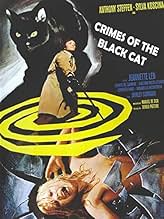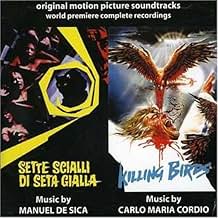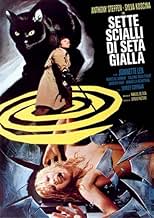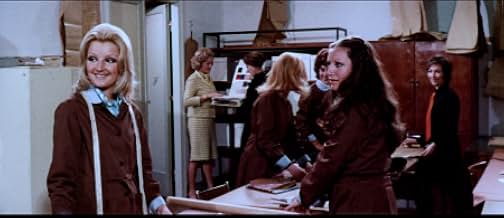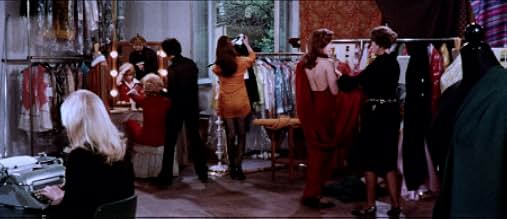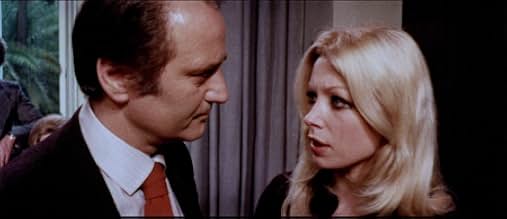NOTE IMDb
6,1/10
1,1 k
MA NOTE
Ajouter une intrigue dans votre langueA blind pianist overhears a conversation in a nightclub, and is determined to figure out who is responsible for a string of strange murders involving a black cat.A blind pianist overhears a conversation in a nightclub, and is determined to figure out who is responsible for a string of strange murders involving a black cat.A blind pianist overhears a conversation in a nightclub, and is determined to figure out who is responsible for a string of strange murders involving a black cat.
- Réalisation
- Scénario
- Casting principal
Giovanna Lenzi
- Susan Leclerc
- (as Jeannette Len)
Isabelle Marchall
- Paola Whitney
- (as Isabelle Marchal)
Lorenzo Piani
- Waiter in Hamburg
- (générique uniquement)
Bruno Alias
- Hairdresser
- (non crédité)
Francesco Anniballi
- Male Nurse
- (non crédité)
Florinda Bolkan
- Carol Hammond
- (images d'archives)
- (non crédité)
Margherita Horowitz
- Atelier personnel
- (non crédité)
Avis à la une
Stop me if you've heard this one before (don't really though) - a black hatted, gloved killer is working his way through the models at a fashion house. Blind composer Anthony Steffan gets caught up in all this nonsense because the first victim is his girlfriend Paola, who about ten seconds previously, dumped the poor guy by letter. That's right - a blind guy, dumped by letter.
Add to that the strange conversation Anthony overhears in his local bar. Someone seems to be blackmailing someone else to do something, but then an annoying hippy throws on a 'groovy' record to 'freak out' to, and Anthony only hears about half the conversation. The waiter describes a woman in a white cape to Anthony, but the other conversationalist must have slipped out a back door, because the waiter didn't seem them. Can I add here however that the record lasts about fifty seconds. Thank God it wasn't some prog or something.
The next day Paola is found dead at the fashion house. It's a kind of locked room mystery, as no one else was there, she has a slight scratch on her face, and there's a yellow shawl lying nearby. Model Margot swears there was a basket in the room too, but that's disappeared. The annoying police, plus Anthony (with sidekick butler Umberto Raho in tow) get right on the case.
There's plenty of suspects too, from hunky Giacomo Rossi-Stuart, second in command at the fashion house and a fanny rat to boot, then there's his missus, the boss of the place. There's also your usual lesbians involved, some gossips, slags, blackmailers. You know the drill by now.
Anthony maybe be blind, but he's no fool. He's one step in front of the police, but one step behind the killer, and what's his dead girlfriend doing in supposed blackmail pictures with Giacomo Rossi-Struart? Someone else gets the old yellow shawl/scratch killing, and Giacomo gets closer to the killer, or at least the person being forced to set up these killings - using his sense of smell!
Sure it's derivative of Mario Bava's Blood and Black Lace (the fashion house) and Argento's Bird With A Crystal Plumage (with the tape recorded clue, and Umberto Raho), there's still loads to enjoy here. There's a great colour scheme (mostly yellow of course!) and Anthony's character is composing the soundtrack to a giallo! When you see footage of it, you'll notice it's Lucio Fulci's Lizard In A Woman's Skin, and as an added bonus, it's the bit that reveals the killer. Good work there.
There's the scene where a character leads Anthony to an glass recycling plant (I think...in 1972?) and leaves him to injure himself amongst all the glass and sudden drops, and a razor killing in a shower that takes the gore level way beyond anything else seen prior to it in the film. The Copenhagen setting is different from the norm too.
Add to that the strange conversation Anthony overhears in his local bar. Someone seems to be blackmailing someone else to do something, but then an annoying hippy throws on a 'groovy' record to 'freak out' to, and Anthony only hears about half the conversation. The waiter describes a woman in a white cape to Anthony, but the other conversationalist must have slipped out a back door, because the waiter didn't seem them. Can I add here however that the record lasts about fifty seconds. Thank God it wasn't some prog or something.
The next day Paola is found dead at the fashion house. It's a kind of locked room mystery, as no one else was there, she has a slight scratch on her face, and there's a yellow shawl lying nearby. Model Margot swears there was a basket in the room too, but that's disappeared. The annoying police, plus Anthony (with sidekick butler Umberto Raho in tow) get right on the case.
There's plenty of suspects too, from hunky Giacomo Rossi-Stuart, second in command at the fashion house and a fanny rat to boot, then there's his missus, the boss of the place. There's also your usual lesbians involved, some gossips, slags, blackmailers. You know the drill by now.
Anthony maybe be blind, but he's no fool. He's one step in front of the police, but one step behind the killer, and what's his dead girlfriend doing in supposed blackmail pictures with Giacomo Rossi-Struart? Someone else gets the old yellow shawl/scratch killing, and Giacomo gets closer to the killer, or at least the person being forced to set up these killings - using his sense of smell!
Sure it's derivative of Mario Bava's Blood and Black Lace (the fashion house) and Argento's Bird With A Crystal Plumage (with the tape recorded clue, and Umberto Raho), there's still loads to enjoy here. There's a great colour scheme (mostly yellow of course!) and Anthony's character is composing the soundtrack to a giallo! When you see footage of it, you'll notice it's Lucio Fulci's Lizard In A Woman's Skin, and as an added bonus, it's the bit that reveals the killer. Good work there.
There's the scene where a character leads Anthony to an glass recycling plant (I think...in 1972?) and leaves him to injure himself amongst all the glass and sudden drops, and a razor killing in a shower that takes the gore level way beyond anything else seen prior to it in the film. The Copenhagen setting is different from the norm too.
The first half of this giallo is fairly undistinguished, especially since it blatantly copies Mario Bava (the fashion-house setting being lifted, yet again, from BLOOD AND BLACK LACE [1964]) and Dario Argento (borrowing its blind hero-turned-sleuth from THE CAT O'NINE TAILS [1971]). However, the film is stylish enough (particularly the zoom-happy murder sequences) and the plot convoluted enough (taking in a plethora of shady characters invariably involved in adultery, drug-taking, blackmail and revenge) to overcome its basic lack of originality; the circus-world back-story, then, should perhaps excuse its uniquely far-fetched murder method...though the seven yellow-silk shawls referred to in the original Italian title are equally insignificant!
The film's pulsating score by Manuel De Sica (son of neo-realist master film-maker and versatile actor Vittorio De Sica) is serviceable but unremarkable, as is the cast led by Anthony Steffen, Sylva Koscina (in what at first appears to be merely an extended cameo) and Giacomo Rossi-Stuart. Its use of nudity is very discreet (though it doesn't appear that any cutting was done, I haven't been able to establish the film's correct running time; the print I watched was around 94 mins. in PAL format, but some sources list versions running as long as 108 mins.!) and the gore only truly surfaces at the very end (with a particularly nasty shower murder, shamelessly ripping off Hitchcock's PSYCHO [1960] - but remaining, for my money, one of the genre's most memorable set-pieces). After the mystery has supposedly been solved (and the revelation of the killer's identity having thus proved quite lame and lazy, in my opinion), the film manages to pull the rug from under our feet - so much so that I had to watch the ending twice! - by providing one final twist. By the way, the decision to conclude the film in mid-sequence on a freeze-frame is another Argento influence, namely FOUR FLIES ON GREY VELVET (1971)!
All in all, a giallo more interesting in its borrowings than for any individual achievements - but one that remains eminently watchable just the same.
The film's pulsating score by Manuel De Sica (son of neo-realist master film-maker and versatile actor Vittorio De Sica) is serviceable but unremarkable, as is the cast led by Anthony Steffen, Sylva Koscina (in what at first appears to be merely an extended cameo) and Giacomo Rossi-Stuart. Its use of nudity is very discreet (though it doesn't appear that any cutting was done, I haven't been able to establish the film's correct running time; the print I watched was around 94 mins. in PAL format, but some sources list versions running as long as 108 mins.!) and the gore only truly surfaces at the very end (with a particularly nasty shower murder, shamelessly ripping off Hitchcock's PSYCHO [1960] - but remaining, for my money, one of the genre's most memorable set-pieces). After the mystery has supposedly been solved (and the revelation of the killer's identity having thus proved quite lame and lazy, in my opinion), the film manages to pull the rug from under our feet - so much so that I had to watch the ending twice! - by providing one final twist. By the way, the decision to conclude the film in mid-sequence on a freeze-frame is another Argento influence, namely FOUR FLIES ON GREY VELVET (1971)!
All in all, a giallo more interesting in its borrowings than for any individual achievements - but one that remains eminently watchable just the same.
Cats, and particularly the black-colored ones, are quite popular animals to feature in horror movies. Mainly thanks to the influence of Edgar Allen Poe's legendary writings, but also because they're sinister and mysterious animals whose actions are largely uncontrollable. Particularly the Italian horror industry used a lot of (black) cats and the story lines often try to fool us into believing these vicious animals are responsible for the ongoing terror, even though there's always duh a human culprit behind it. Sergio Pastore's "Crimes of the Black Cat" is a very competent Giallo, perhaps a bit standard and obviously borrowing ideas from similar efforts, but nevertheless entertaining enough to please the majority of fans of this marvelous Italian horror sub genre. What story aspects are borrowed from other Giallo-titles? Well, the victims of the maniacal killer are nearly all gorgeous models working for the same fashion house, as it was the case in Mario Bava's "Blood & Black Lace"; generally considered as THE movie that started the whole Giallo-madness in 1964. Also, the male lead who begins to investigate the murders on his own is blind, like Karl Malden's character in Dario Argento's "The Cat O'Nine Tails". The most important elements in Sergio Pastore's script are original however, like the modus operandi used for the killings and the large amount of red herrings & convoluted plot twists when approaching the finale. The lifeless body of a young model is found in her dressing room. She seemly died of a sudden heart attack but closer investigation shows that the claw of a cat dripped in poison caused her premature death. Since the police don't seem to be in a hurry to find the person behind this fiendish murder, the girl's former boyfriend Peter (a blind pianist) starts his own search, assisted by his loyal butler and the murdered girl's roommate. They slowly unravel a whole criminal network involving adultery, blackmail and drug-addicted circus artists. "Crimes of the Black Cat" is reasonably well paced and features a satisfying amount of action and excitement. The first 15 minutes are rather tame, but this is widely compensated by the outrageous and suspense-laden climax. The cat-claw murders aren't very spectacular, but there's a truly sadistic and stomach-churning scene near the end in which a poor girl is stabbed to death in her, "Psycho"-style in her shower. This particular murder surely belongs in the top ten grossest Giallo-moments! Unlike other contemporary Giallo-highlights, the musical score is unmemorable and there isn't that much female nudity on display. Pastore's direction and the performances of the ensemble cast are just adequate without surpassing any exceptional boundaries. "Crimes of the Black Cat" perhaps shouldn't be the first film to watch when you're new to the Giallo-sub genre, but it's definitely a good film that I warmly recommend.
One thing you can say about Italian gialli: they never resort to killing someone with a simple shooting or stabbing--the villains always use some ridiculously elaborate Rube Goldberg method for doing their victims in. And this giallo features what might be the most ridiculous of them all. I don't want to give too much away, but I will say that the English title "Crimes of the Black Cat" can be taken completely literally. (Obviously, the people who thought up this movie were not cat owners--have you ever tried to get a cat to do ANYTHING?). Aside from the especially absurd murders this is a typical giallo. It is set in the European fashion world, it's highly stylized, the plot makes little sense, and the motivation of the villain turns out to be even more ludicrous than the method of murder.
The protagonist is the blind male lover of the first murder victim. (How come blind people never complain that they are always being stereotyped as good-looking and resourceful individuals who always get to solve the crime and sleep with many attractive members of the opposite sex along the way?). The only name star is Sylva Koscina, but she is barely in the movie. The best actor though is the cat (perhaps the self-same feline thespian who played "Satan" in "Gently, Before She Dies"). After he exits the film, it quickly spirals downward with a truly tasteless shower murder and one of those abrupt freeze-frame endings that were so big in the 70's (maybe they ran out of film a lot back then). If you like gialli at all though, you'll probably like this one. It's very typical for its kind.
The protagonist is the blind male lover of the first murder victim. (How come blind people never complain that they are always being stereotyped as good-looking and resourceful individuals who always get to solve the crime and sleep with many attractive members of the opposite sex along the way?). The only name star is Sylva Koscina, but she is barely in the movie. The best actor though is the cat (perhaps the self-same feline thespian who played "Satan" in "Gently, Before She Dies"). After he exits the film, it quickly spirals downward with a truly tasteless shower murder and one of those abrupt freeze-frame endings that were so big in the 70's (maybe they ran out of film a lot back then). If you like gialli at all though, you'll probably like this one. It's very typical for its kind.
De Sica's below-average score notwithstanding (and they do count a lot in these movies, don't they?) this is a satisfying giallo with all the key elements included and none of them bungled. Granted, a lot of those key elements are ripped right from other movies, and the direct influence of Psycho, Black Belly of the Tarantula, Blood and Black Lace, Lizard in a Woman's Skin and most of all Cat O'Nine Tails doesn't win it points for creativity, but it's all handled as though it were the first film ever made so you don't really mind. The plot, with its typically and gloriously dumb motive for the killings (in this case a car crash in the past, as was the case with Seven Orchids Stained in Blood) moves along at a fair pace, and making the hero blind gives him a sympathetic attraction most giallo heroes lack. It's not as good as any of the films from which it's descended but nevertheless a solid entry in the genre.
Le saviez-vous
- AnecdotesAnthony Steffen was dubbed by Edmund Purdom for the English language version.
- GaffesAfter the cat lady's death, the newspaper headline misspells "mystery", as in "The mistery (sic) of the black cat still goes on."
- ConnexionsFeatures Le venin de la peur (1971)
Meilleurs choix
Connectez-vous pour évaluer et suivre la liste de favoris afin de recevoir des recommandations personnalisées
- How long is The Crimes of the Black Cat?Alimenté par Alexa
Détails
- Date de sortie
- Pays d’origine
- Langue
- Aussi connu sous le nom de
- The Crimes of the Black Cat
- Lieux de tournage
- Copenhague, Danemark(location)
- Sociétés de production
- Voir plus de crédits d'entreprise sur IMDbPro
- Durée1 heure 39 minutes
- Mixage
- Rapport de forme
- 2.35 : 1
Contribuer à cette page
Suggérer une modification ou ajouter du contenu manquant

